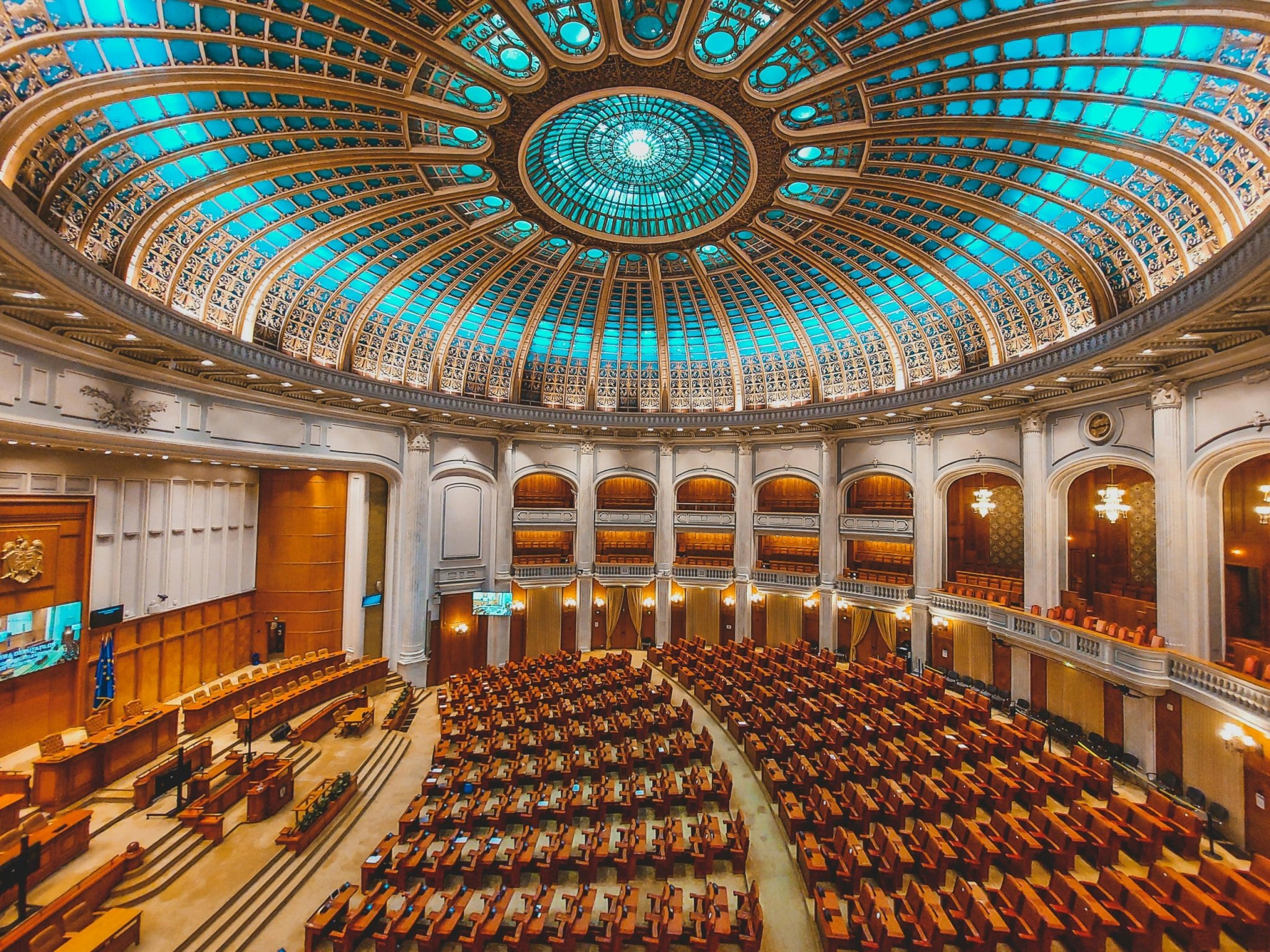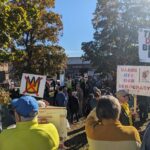
At Boston Common, the nation’s oldest public park, a drone video showed that up to 125,000 people attended last Saturday’s “No Kings” protest. The Boston protest was one of about 2,700 coordinated events, attracting nearly 7 million people nationwide.
In Boston, the rally was two events in one. One involved the usual mix of elected officials and prominent community leaders giving speeches to the crowd.
The other, also held in the park about a quarter mile from the first, served as a kind of community fair for rallygoers to connect with local groups and stay engaged after the rally ended. And it was packed—moving from table to table often required jostling.
Among those tabling was the Boston chapter of the Federal Unionists Network (FUN). At their table, they had a large wheel for passersby to spin to answer questions about federal agencies. (Example: “What department is the US Passport Office part of?” Answer: “The State Department.”) The workers also sought donations for federal workers trying to pay bills during the shutdown, dovetailing with efforts online, such as the CDC Mutual Aid Network.
“The public is not aware of how federal cuts directly impact them. People don’t know.”
At the rally, a number of federal workers spoke with NPQ. Corey Sung, a passport office worker and organizer with FUN, said it was important for federal workers to show up at rallies like the “No Kings” protest and be heard.
“Most of us are on furlough or are working and not paid,” he observed. Sung added, “The public is not aware of how federal cuts directly impact them. People don’t know. They don’t understand how it impacts [their] family.”
Rallies like this one, he said, give federal workers a chance to directly educate the public on how federal services affect them directly.
A Government Shutdown in Slow Motion
Officially, the US federal government has been “shut down” since October 1. The theater of shutdowns and the complicated rules regarding which agencies actually shut down and which (such as US Immigration and Customs Enforcement) do not, is a story in itself. Until 1980, if spending authorization ran out, federal agencies typically just spent money on the assumption that future appropriations would catch up—a pretty sane thing for an entity serving the public to do. Indeed, this is the way that democratic governments operate nearly everywhere else in the world. We in the US can blame the administration of President Jimmy Carter for creating this mess in the name of accountability.
This year’s shutdown has gotten less press attention than most, though. Indeed, speakers at the rally hardly mentioned it. There is a reason for that. As Ellen, a USDA Food and Nutrition Service worker (who asked that only her first name be used) told NPQ, the agency where she has worked has been “effectively shut down since January.”
“Even without the shutdown, it is not possible to do [federal civil rights] investigations.”
Ellen added that under the Donald Trump administration, her Northeast regional office has lost half its staff. Other changes have added to inefficiency and ineffectiveness. For example, ordering everyone to work in sometimes noisy offices has made phone conversations—a key part of the job—more difficult. Meanwhile, guidance on how to implement food stamp cutbacks included in the Trump budget bill passed in July has yet to be issued.
Beyond administering food stamps (officially, the Supplemental Nutritional Assistance Program or SNAP), agency workers also help meet emergency needs. For instance, when food is transported and not kept at the right temperature or cans are dented, Ellen noted that “food banks call us.” Agency workers, she explained, counsel food banks about when food is still safe and when it is not, thereby helping “keep people safe and fed.”
The struggles that Ellen reports are not unique to her agency. At the US Department of Education, Ariel Shepetovskiy was enthusiastic when she got hired as a new attorney in the department’s Office of Civil Rights in September 2024. Her job was remote, based out of the regional office in Cleveland, OH. The job, she shared, involved a range of cases, from advocating for a student with a disability who was unable to attend class due to their school’s nonfunctioning elevator, to investigating reports of the use of racial slurs creating a hostile learning environment for children.
She had anticipated working there for ten to 20 years, but instead the entire office of roughly 30 people was shuttered as part of a regional consolidation. She received a reduction-in-force (RIF) notice in March. A court case is pending, but she accepted a private sector job as an immigration attorney and has resigned her position. She says that former coworkers who have transferred to other offices inform her that caseloads have increased dramatically, climbing from about 50 per attorney to 300.
“The work…is simply not happening anymore,” she added. “Even without the shutdown, it is not possible to do investigations.”
Impacts in Health and Environmental Protection
NPQ spoke with two more federal workers who requested anonymity to share their stories. One, who had worked at the US Department of Health and Human Services (HHS) for nine years, noted that their entire branch of 100 people was “all gone.” The firings occurred on April 1 and are still being challenged. The dismissals, they said, were first communicated by text message at 5:00 am and were followed by RIF emails that were riddled with errors.
This worker noted that they had helped to run a national effort supporting educational programs to encourage HIV/AIDS testing, including the distribution of home tests, especially to marginalized communities. The firings, this worker noted, came after a gag order had been instituted in February, preventing staff from communicating with a number of nonprofit partners. The grants were subsequently stopped. The person added that the team continues to challenge the dismissals and is holding regular update calls.
The other worker was an employee at the US Environmental Protection Agency (EPA). Their Northeast regional office had suffered fewer cuts than some, although the office had lost about a quarter of its staff, roughly 150 people. This worker, who manages environmental cleanup grants, said that 10 hours a week of their job is now spent scrubbing the phrases “climate change” and “environmental justice” from already approved grant applications. “We go through every document and ditch those two phrases,” they said. “You never had to do so retroactively” before this administration, they added.
A Larger Struggle
Back at the main stage, federal worker concerns were not front and center, although Kevin Brousseau, secretary-treasurer of the Massachusetts American Federation of Labor and Congress of Industrial Organizations (AFL-CIO) did point out that the Trump administration’s combined downsizing of the workforce and cancellation of collective bargaining agreements mark the “largest act of union busting in American history.”
The struggle is “not just about one dishonest man. We’ve been struggling for a long time with the lie that our problems are with our neighbor.”
Key themes emphasized by the speakers included the need to protect immigrants and to defend against the threat of National Guard occupation. In her remarks, Boston Mayor Michelle Wu invoked solidarity with cities that have recently faced unwanted federal presence: “We stand with LA and Portland, DC, Memphis, and Chicago.”
Many speakers, too, cautioned against taking the “no kings” slogan too literally, as if the occupant of the White House were the sole problem. Rev. Mariama White-Hammond of New Roots AME Church, who was master of ceremonies for the 2017 Boston Women’s March, cautioned attendees that the struggle is “not just about one dishonest man. We’ve been struggling for a long time with the lie that our problems are with our neighbor. We’ve been told the problems are not with the people at the top but the people at the bottom.”
Many speakers called out how power has become more concentrated at the top. Massachusetts Attorney General Andrea Joy Campbell called on attendees to “resist corporate greed and capitalism that is on steroids.” US Senator Ed Markey (D-MA) decried the power of “billionaire CEOs,” adding that “too much is in the hands of too few.”
Representative Ayanna Pressley (D-MA) closed her remarks by offering her take on the goals of the assembled crowd: “We draw strength from one another, from community, from this movement,” she said. “We will resist. We will agitate. We will organize. And we will mobilize. Because we know another world is possible; one that chooses people over profit, diversity over nationalism, peace over war, hope over fear, love over hate, and freedom over fascism.”














